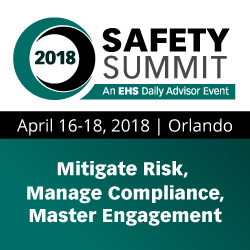Although the Occupational Safety and Health Administration (OSHA) delayed enforcement of the respirable crystalline silica rule for construction, don’t expect the same for the general industry rule. Enforcement for the general industry and maritime rule begins June 23, 2018—exactly as scheduled.

Silica dust has been part of the OSHA National Emphasis Program for many years, so it has always been a focus of Agency inspections. But, now, with the lower permissible exposure level (PEL) set, it will likely be scrutinized even more.
Why is OSHA so focused on silica dust? Because of the serious health effects of exposure. Employees exposed to silica dust are at increased risk of developing serious adverse health effects, including silicosis, lung cancer, chronic obstructive pulmonary disease, and kidney disease. The rule provides steps that employers are required to take to protect workers from the hazards of respirable crystalline silica.
Silica is found in many naturally occurring materials and used in many industrial products and at construction sites. Materials such as sand, concrete, stone, and mortar contain silica. Crystalline silica is also used to make products like glass, pottery, ceramics, bricks, concrete, and artificial stone. Workers are also exposed during abrasive blasting and when industrial sand containing silica is used, such as in foundry work and hydraulic fracturing (fracking) operations.
What you need to know to comply
The respirable crystalline silica rule reduces the PEL to 50 micrograms of silica per cubic meter (50 µg/m3) of air over an 8-hour time-weighted average (TWA) across all industries.
The rule also introduces an action level of 25 µg/m3 over an 8-hour TWA. This means that you must demonstrate that workers will not be exposed to silica dust at or above that level in “any foreseeable circumstances.”
If there are operations at your facility where the silica level could reach this “action level,” you must conduct exposure assessments to measure worker exposure. These exposure assessments are used to determine what worker protections need to be put in place.
Protections for worker exposure
Table 1
The rule allows general industry workplaces to use Table 1 of the construction rule (29 CFR 1926.1153(c)) for work tasks that are “indistinguishable” from the 18 work tasks listed in the table.
According to OSHA, “Table 1 matches common construction tasks with dust control methods, so employers know exactly what they need to do to limit worker exposures to silica. The dust control measures listed in the table include methods known to be effective….”
If you follow Table 1—fully and properly implementing all controls and work practices—you are not required to quantify silica exposure levels and are not subject to the PEL.
Two options for exposure assessment
You can choose between two options for assessing exposure:
- The performance option: Employers can use “any combination of air monitoring data or objective data sufficient to accurately characterize employee exposures to respirable crystalline silica,” but “[w]hen using the performance option, the burden is on the employer to demonstrate that the data accurately characterize employee exposure.”
- The scheduled monitoring option: The employer can monitor “each employee on the basis of one or more personal breathing zone air samples that reflect the exposures of employees on each shift, for each job classification, in each work area” and remonitor as needed.
Additional compliance requirements
The rule also requires that you:
- Develop a written exposure control plan that identifies tasks that expose workers to silica dust and measures taken to protect workers.
- Train workers on the health hazards of exposure to silica dust, on job tasks that result in exposure to silica dust, and ways to limit exposure.
- Use engineering and work practice controls to reduce exposure.
- Avoid housekeeping practices that could cause silica dust to become airborne, like dry sweeping and using compressed air when alternatives are available.
- Establish regulated areas where tasks are performed that result in silica dust exposure that exceeds the PEL.
- Provide respirators and personal protective equipment (PPE) when control methods do not sufficiently reduce exposure.
- Offer medical surveillance exams to workers highly exposed to respirable crystalline silica.
- Maintain records of workers’ occupational exposure and medical exam reports.
You can learn more about complying with the silica rule by attending BLR’s Safety Summit 2018, April 16–18, at SeaWorld Orlando, where attorney Adele Abrams will present the educational session What You Need to Know About OSHA’s New Silica Rule for General Industry: Best Practices, Training, Recordkeeping, and More. Abrams will outline the requirements under the new rule, sampling strategies, the rule of objective data, development of site-specific exposure control plans, medical surveillance, workers’ training, and more.
Safety Summit is the nation’s leading safety conference to experience inspiring keynotes; best practice-rich general sessions; and targeted, tracked sessions on the latest risk management/OSHA compliance developments and practical, use-them-now strategies on how to improve safety performance at your organization.